I remember the days when employee training meant sitting in a conference room with a stack of printouts, pretending to pay attention. Those days are long gone. Today, training isn’t just a necessity—it’s a strategic advantage.
In 2025, recruitment is marketing, onboarding is an experience, and eLearning? It’s a $314 billion industry reshaping how companies train, retain, and engage employees. The smartest companies aren’t just keeping up—they’re leading the way, using cutting-edge training to boost productivity, cut costs, and keep employees invested.
I’ve gathered 100+ data-backed employee training stats from top sources to prove why training isn’t optional—it’s essential.
I won’t try to convince you that employee training is essential—just let the numbers do the talking. 😉
Let’s get into it.
Skills Gap Stats
The skills gap isn’t just a future problem—it’s happening right now. Companies across the globe are struggling to find qualified talent, and the consequences are massive.
Here’s a look at just how deep the issue runs:
- 87% of executives are either already facing or anticipate facing skill shortages in their workforce within the next few years. (McKinsey Global Survey)
- By 2030, the global skills gap could lead to $8.5 trillion in lost annual revenue. (Korn Ferry)
- The 74 million next-generation workforce of 15- to 24-year-olds who are unemployed are not skilled enough to fill the skills gap. (IBM)
- Three out of four employers say they are struggling to find workers with the right skills. (Euro News)
- By 2030, Russia may face a labor shortage of up to 6 million people, while China’s shortage could be double that figure. (Korn Ferry)
- In the tech sector alone, the U.S. risks losing $162 billion in annual revenue if it fails to address the shortage of high-tech workers. (Korn Ferry)
- More than a third (34%) of workers believe they possess skills that are not reflected in their qualifications or job titles. (PwC)
- More than 65% of global leaders cite “talent and leadership shortages” as their #1 business challenge. (IBM)
- The skill requirements for modern jobs have shifted by 25% since 2015 and are projected to double by 2027. (LinkedIn)
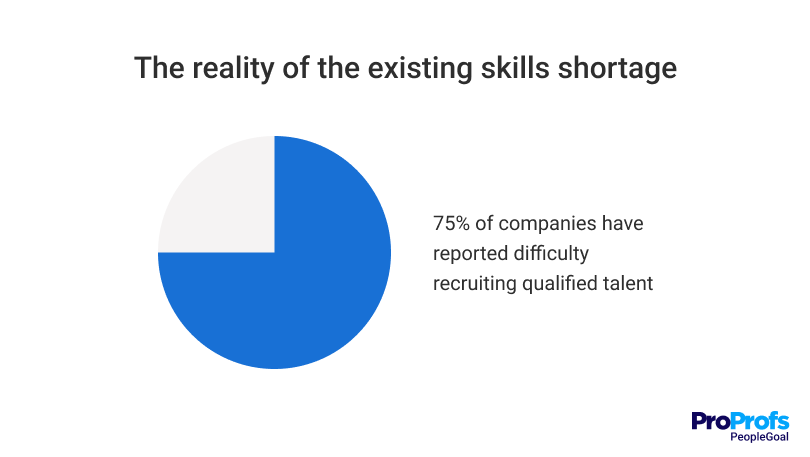
Employee Training Stats
Investing in employee training isn’t just a perk—it’s a business necessity. The right training programs can boost productivity, increase retention, and drive higher profits.
Here’s what the numbers say:
- Companies with strong training programs see 218% higher income per employee, enabling the company to enjoy a 24% higher profit margin. (Forbes)
- Well-trained employees make companies 17% more productive, proving that investment in development pays off. (Devlin Peck)
- 59% of employees say training directly improves their performance, yet many workplaces still underinvest in learning. (Devlin Peck)
- 68% of employees prefer learning on the job, highlighting the need for workplace-integrated training programs. (Research.com)
- 94% of workers are more likely to stay if their company invests in training. (Harvard Business Review)
- Over 90% of employees say they wouldn’t quit if they had access to career development opportunities. (Next Job)
These employee training stats sound interesting, right? Well, there are more
- 92% of employees believe well-planned training programs improve their engagement at work. (LinkedIn Learning)
- Employees acquire 70% of their skills on the job, with only 10% from formal training—showing the importance of hands-on learning. (Training Industry)
- More than half (55%) of employees feel they need extra training to improve their performance. (SHRM)
- The global corporate training market was valued at USD 163.5 billion in 2023 and is projected to grow from USD 176.58 billion in 2024 to USD 326.84 billion by 2032, with a CAGR of 8.0% during the forecast period (2025-2032). (The Business Research Company)
- Only 41% of U.S. employees receive formal training. Statistics show that 52% of companies offer a week or less of training, and 60% of employees say they’ve never had formal training. (Zippia)
- 40% of employees quit within a year due to bad training. (Yahoo Finance)
- 94% of employees stay longer at companies that invest in their development. (LinkedIn Workplace Learning Report)
- The global skills gap could cost the economy $11.5 trillion by 2030. (World Economic Forum)
- More than 8 in 10 hiring managers view employee training positively when attracting candidates. (Devlin Peck)
- Less than 10% of the firms have ever invested in training one of their employees. (Institute for the Study of Labor)
Now here are some employee training stats that will blow you!
- 67% of learners prefer tech-enabled learning (LinkedIn’s 2024 Workplace Learning Report).
- According to a study done by Zippia, out of 1,000 employees, 31% leave within their first six months. This issue worsens when there’s a lack of training, which is the main reason many employees quit. (Zippia)
- 94% of employees won’t quit if they’re offered training and development opportunities. (Zippia)
- 92% of employees say that the right kind of formal workplace training impacts their job engagement positively. (Axonify)
- 80% of employees say that receiving regular and frequent training is essential to retaining information, an increase from 73% in the previous year’s study. (Axonify)
- Increasing the average training hours per employee by 10 hours raises output by 4%. (Institute for the Study of Labor)
- The marginal product of a trained worker is, on average, 23% higher than that of an untrained worker. (Institute for the Study of Labor)
- Labor productivity in training firms is 27% higher than in non-training firms. (Institute for the Study of Labor)
- The wages of trained employees are 16.7% higher than the wages of untrained employees. (Institute for the Study of Labor)
- 84% of employees in Best Performing Organizations are receiving the training they need compared with 16% in the worst performing companies. (IBM)
- Increasing team skills by 1/3 increases the likelihood of stakeholders meeting their objectives from 10% to 100%. (IBM)
Interesting, right? Do not miss these employee training stats:
- Skill levels linked to business value, $70,000 in annual savings, and a 10% increase in productivity when teams are well-trained. (IBM)
- 75-80% of managers believe effective training is critical to project success and meeting project deadlines. (IBM)
- Only 21% of new hires intend to stay at companies that do not offer training for their current jobs. (IBM)
- Training helps reduce the project delivery time by 22%. (IBM)
- The marginal product of a trained worker is about 23% higher than that of an untrained worker. (Institute for the Study of Labor)
- On average, a trained employee earns 12% more than their untrained counterpart. (Institute for the Study of Labor)
- Teams receiving 40 hours of training per member met their significant project objectives three times as often as teams that received 30 hours of training or less. (IBM)
Beyond retention, providing training to employees builds an environment where they thrive. Companies with a strong learning culture are:
✅ 92% more likely to develop novel products and processes
✅ 56% more likely to be first to market (Bersin by Deloitte)
The bottom line? Investing in employee training isn’t just a “nice-to-have”—it’s a non-negotiable for companies that want to stay ahead.

Corporate eLearning Stats
E-learning is transforming workplace training by making it faster, cheaper, and more effective. Companies investing in it are seeing major gains in productivity and retention.
Here’s the data to prove it.
- By 2028, the corporate eLearning market is expected to reach $44.6 billion. (Valuates Reports)
- Over 40% of Fortune 500 companies use eLearning platforms for workforce training and upskilling. (Fortune India)
- Traditional face-to-face training has retention rates of 8-10%, while eLearning boosts retention to 25-60%. (Fortune India)
- IBM saved $200 million by shifting portions of its workforce training to eLearning. (Fortune India)
- Dow Chemicals reduced training costs from $95 per learner to just $11, saving $34 million through eLearning adoption. (Research.com)
- Companies using eLearning see 18% higher employee engagement. (Molly Fletcher)
- eLearning allows users to absorb 5 times more material without increasing training time. (eLearning industry)
- IBM managers learned 5x more content at one-third of the cost with eLearning integration. (KPMG)
- 42% of companies report revenue growth from eLearning due to improved workforce productivity and performance. (Shift eLearning)
- Every dollar invested in online training generates approximately $30 in increased productivity by accelerating skill application and reducing training time. (Shift eLearning)
- 67% of U.S. companies have implemented mobile learning, enabling employees to access training via phones and tablets. (Shift eLearning)
- Employees remember information 67% better from videos than from text alone. (Zippia)

SOURCE: Zippia
Corporate training plays a crucial role in enhancing workforce skills across various industries. Different sectors invest in training programs to improve employee performance, boost productivity, and stay competitive in the market.
The table below graph the percentage of industries incorporating corporate training:
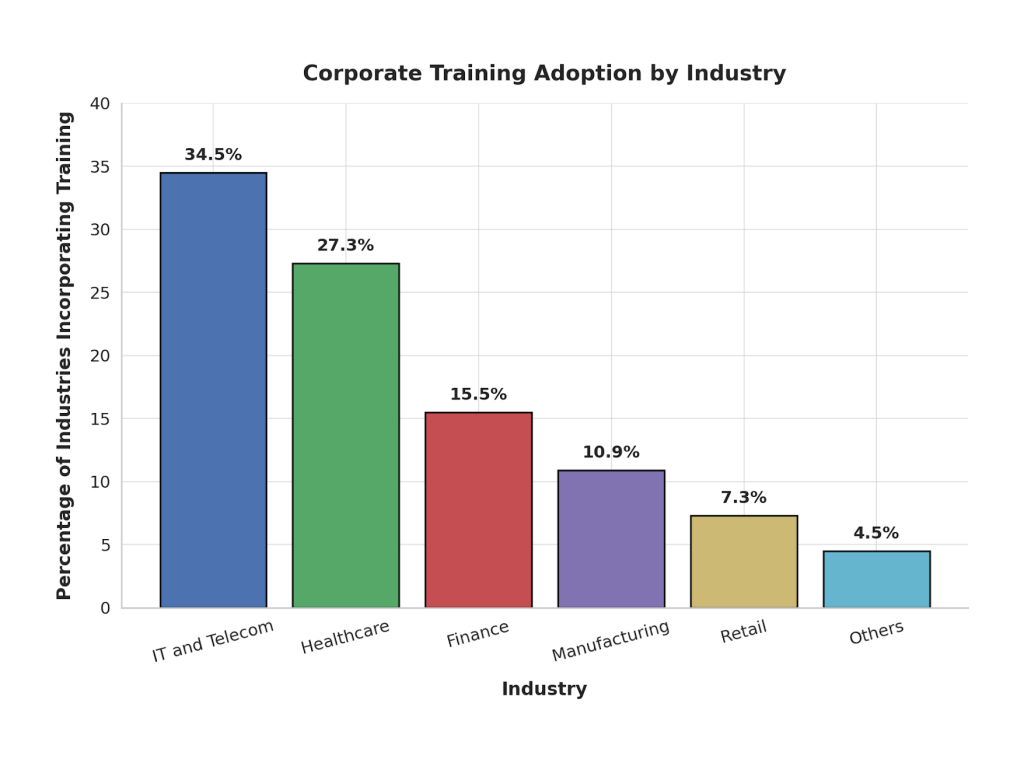
Soft Skills Training Stats
Hard skills might get your foot in the door, but soft skills determine how far you climb. Strong communication, problem-solving, and leadership make the difference between a good employee and a great one. Companies that invest in soft skills training build better teams, boost performance, and keep employees engaged.
Here are some employee training stats that prove the point:
- A study by Harvard University, the Carnegie Foundation, and Stanford Research Center found that 85% of career success depends on strong soft and interpersonal skills, while technical skills contribute just 15%. (National Soft Skills Association)
- In a recent report by Wiley Workplace Intelligence, 74% of the respondents stated that their organizations offer professional development for employees; just 35% say their companies offer soft skills training. (Economic Times)
- According to another Wiley Workplace Intelligence report, almost 63% of individuals who received soft skills training in the past, reported an improvement in their job performance. (Wiley Newsroom)
- While 80% of women recognize the importance of soft skills, an even higher 90% of men see them as valuable in the workplace. (Forbes)
- 71% of employees think soft skills will be just as important, if not more, in the future. (Forbes)
- Communication tops the list of most valuable soft skills for new hires (25%), followed by problem-solving (21%) and time management (19%). (Forbes)
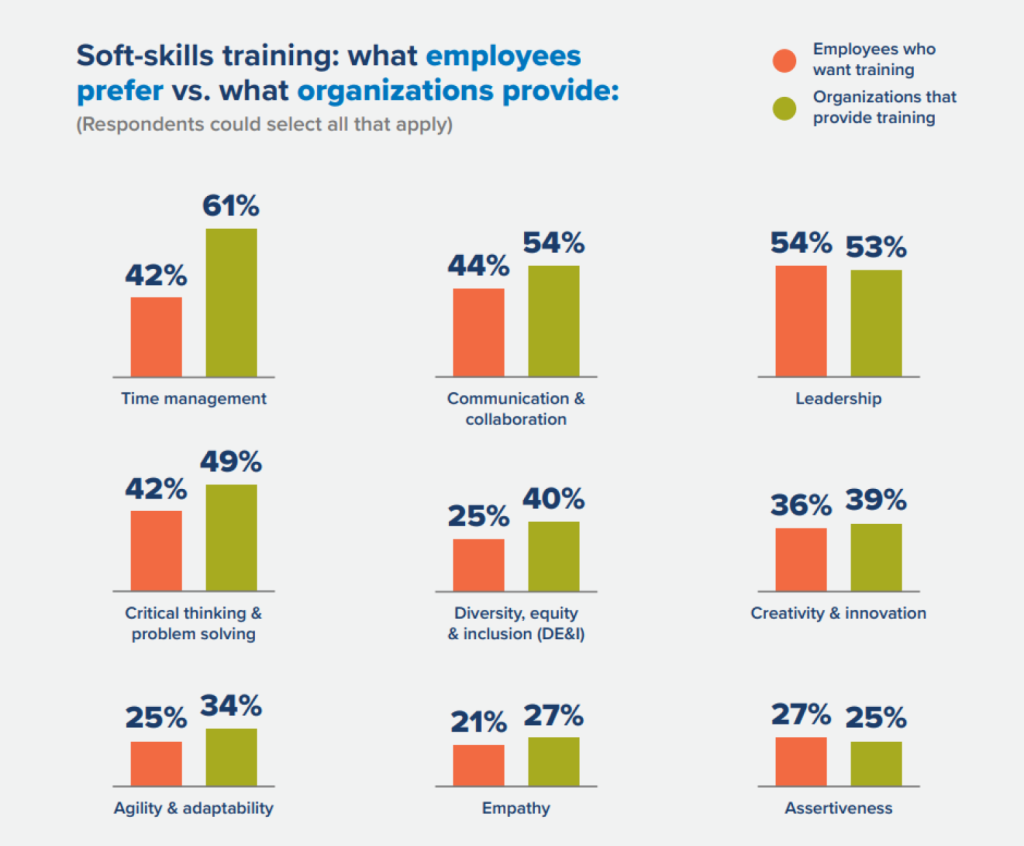
Source: SHRM
L&D and HR Training Stats
Employees aren’t just hoping for career growth—they’re actively seeking it. Whether it’s upskilling, career development, or even mental health training, the demand for learning has never been higher. Companies that prioritize L&D aren’t just filling skill gaps; they’re building loyalty, improving retention, and staying ahead in the talent game.
Here are some stats to prove the point:
- Over 22 million workers in the UK believe they lack the necessary skills to take advantage of new opportunities in the next five years. (City & Guilds annual skills index 2021)
- 94% of employees say they’d stay longer at a company that invests in their learning and development. (Workplace Learning Report)
- 48% of workers in the United States would be willing to switch jobs if offered skills training opportunities (Forbes)
- 65% of employees believe employer-provided upskilling is very important when evaluating a potential new job. (Forbes)
- 76% of employees are more likely to stick around if their employer offers continuous learning and growth. (AIHR)
- If given a larger L&D budget, 72% of HR managers would prioritize investing in mental health and well-being training. (Forbes)
- One in two employees actively seek learning opportunities on their own beyond the training provided by their workplace. (Forbes)
The following graph displays the annual budget per employee that U.S. companies allocate for learning and development (L&D):
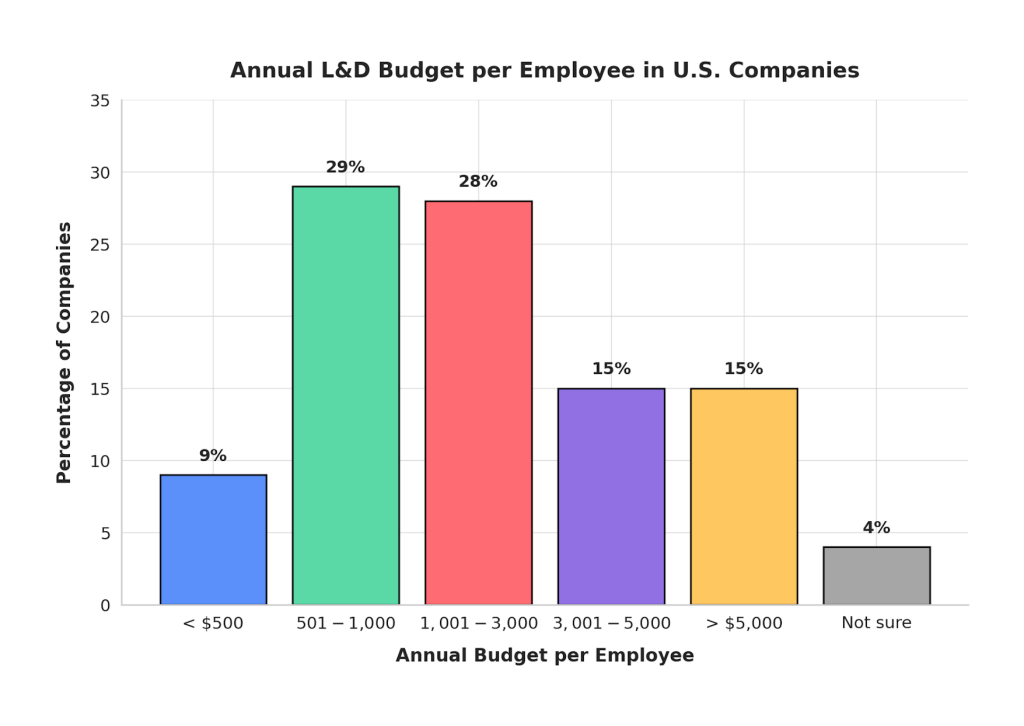
SOURCE: The State of L&D and SHRM
Mobile Learning Stats
Corporate learning is no longer confined to boardrooms and lengthy training sessions. Mobile learning and microlearning allow employees to upskill on the go—whether they’re traveling for work or between meetings.
The numbers don’t lie—mobile learning and microlearning are changing the game for corporate training. Here’s the proof.
- 71% of millennial learners prefer mobile learning. (Mark in Style)
- 72% of organizations surveyed believe eLearning enhances their competitive advantage by enabling them to stay updated with market changes. (Devlin Peck)
- Mobile learning completion rates are 45% higher than traditional e-learning. (edu Me)
- A study revealed that 70% of participants felt more motivated to learn when taking courses on their smartphones. (Sciedu)
- The Mobile Learning Market was valued at USD 58.7 billion in 2023 and is projected to grow at a CAGR of over 16% from 2024 to 2032. (GMInsights)
- 47% of organizations currently use mobile devices in their training programs, and roughly 50% of all organizations understand the importance of providing mobile-friendly content to their employees. (Toward Maturity Org)
- A study by Britain’s Open University found that creating and delivering eLearning courses use 90% less energy and generate 85% fewer CO2 emissions per student compared to traditional in-person courses. (Knowledge Direct)
- 78% of employees prefer micro-certifications over degrees (EdX 2024 Report).
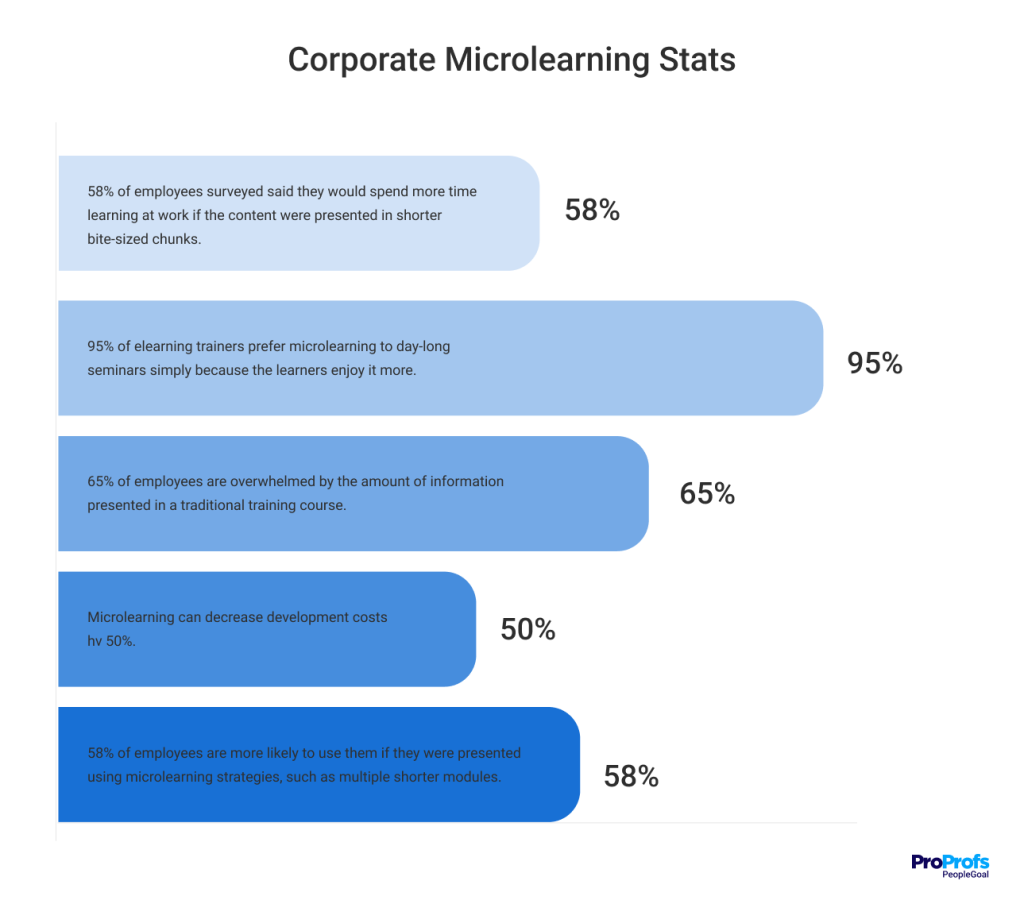
Employee Retention Stats
Employees aren’t just looking for a paycheck—they’re looking for growth. When companies invest in training, they don’t just upskill their teams; they build loyalty, boost engagement, and keep top talent from walking out the door.
Here’s what the numbers reveal.
- Companies that promote learning have a 30-50% higher employee retention rate. (Zippia)
- Companies that spend money on employee training make 24% more profit. (SC Training)
- Employees who are engaged are 23% more likely to be productive and help create a positive work environment. (SC Training)
- 45% of employees would stay with a company longer if it invested in their training and growth. (Zippia)
- 74% of employees are open to learning new skills or retraining to keep their jobs. (Zippia)
- 34% of employees left their previous jobs because they lacked training and career growth opportunities. (Zippia)
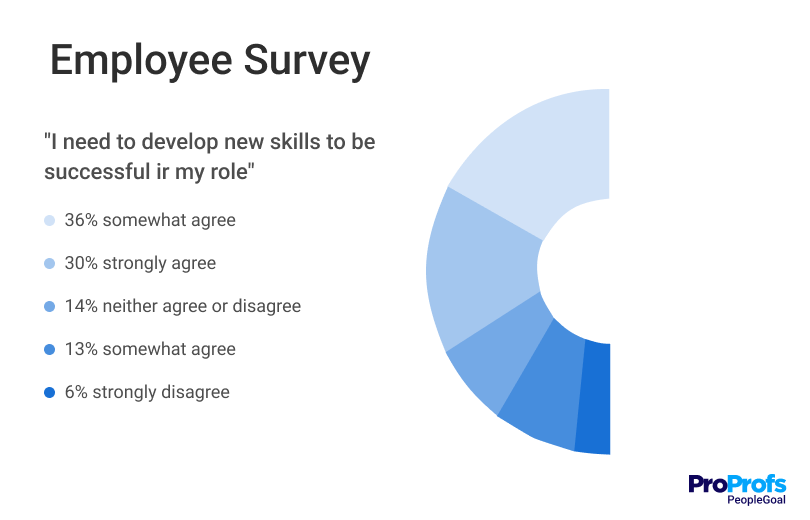
What Do The Employees Want
Employees aren’t just asking for training—they’re asking for training that works for them. They want learning that’s flexible and relevant and actually helps them grow in their careers. Here’s what they’re looking for.
- 91% of employees prefer training that is tailored to them. (Zippia)
- 93% of employees prefer training that is simple and easy to complete. (Zippia)
- 89% of employees want training that is accessible anytime and anywhere to help them with their jobs. (Zippia)
- 68% of employees prefer to learn while working. (Zippia)
- 76% of millennials say professional development is key to a strong company culture. (Zippia)
- Only 29% of employees are very happy with their career growth opportunities. (Zippia)
- 41% think boring training programs make learning harder. (Zippia)
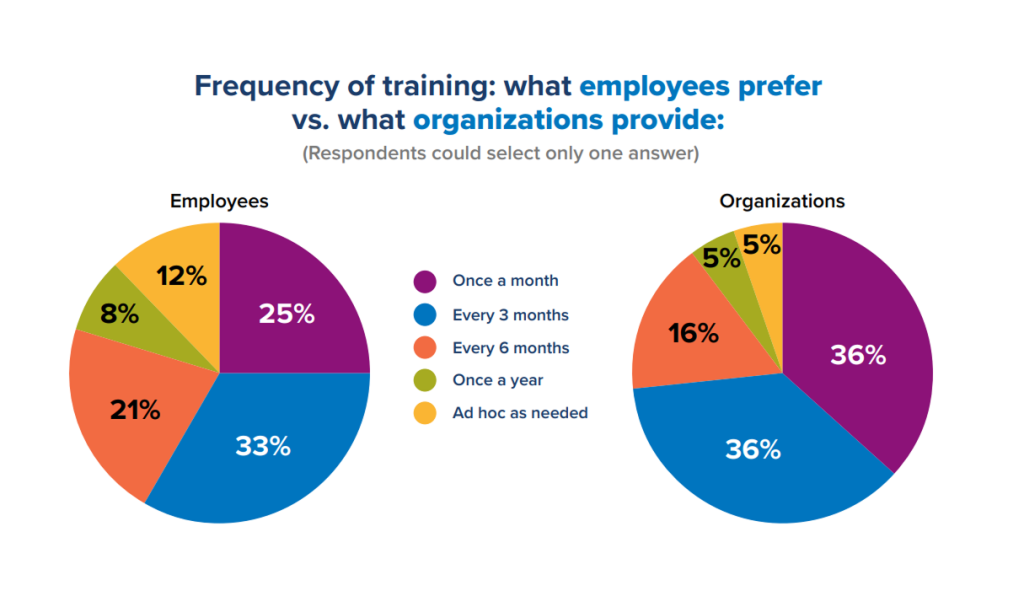
Source: SHRM
Emerging Trends Stats
The future of learning isn’t just about keeping up—it’s about staying ahead. As AI, automation, and shifting job demands reshape the workplace, companies that prioritize upskilling and reskilling will have the competitive edge.
Here’s what’s coming next:
- Executives estimate about 40% of their workforce will need to reskill over the next three years due to AI and automation. (IBM)
- The corporate training market is expected to surpass $487.3 billion by 2030, growing at a CAGR of 8% from 2021 to 2030. (Allied Market Research)
- The required skill sets for jobs have changed by 25% since 2015 and are expected to double by 2027. (LinkedIn)
- By 2025, workforce changes will drive L&D transformation, with 73% of organizations investing in technology to integrate AI, design, and culture for business growth (Brandon Hall Group HCM Outlook 2025).
Do You Agree to These Employee Training Stats?
Do you believe that these employee training stats speak for themselves? Companies with strong employee training programs are more profitable, more productive, and have higher retention rates. Employees want to grow, and when given the opportunity, they perform better, stay longer, and contribute more to the business.
We’re in a skills-first economy where learning is no longer a “one-and-done” event—it’s an ongoing process. Businesses that prioritize training will outpace the competition, attract top talent, and future-proof their workforce. Those that don’t will struggle to keep up in an environment where adaptability is key.The real question isn’t whether training is worth the investment—it’s whether you’re ready to build a company that attracts, retains, and empowers top talent.
Employee performance management tools like PeopleGoal make it easier to create a culture of continuous learning, helping businesses develop their teams and drive success. The companies that embrace this are the ones shaping the future.
Frequently Asked Questions
What are the latest trends in employee training and eLearning?
The latest trends in employee training include AI-powered learning, microlearning, mobile learning, gamification, and personalized training experiences.
How does gamification improve employee learning?
Gamification uses points, leaderboards, badges, and rewards to increase engagement and motivation. Studies show that employees trained through gamification are 48% more likely to complete courses and retain information longer than those using traditional methods.
Ready to 3x Your Teams' Performance?
Use the best performance management software to align goals, track progress, and boost employee engagement.






